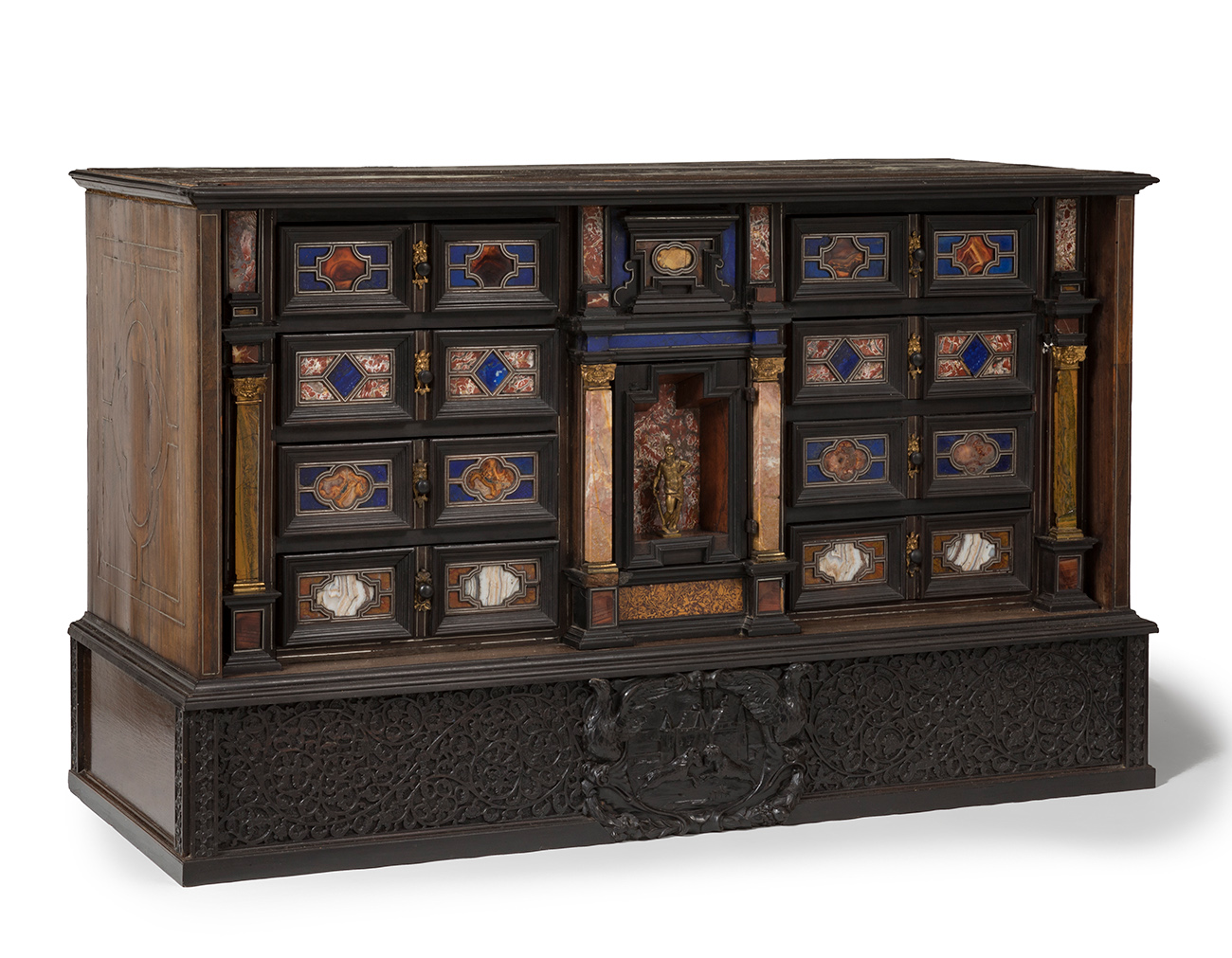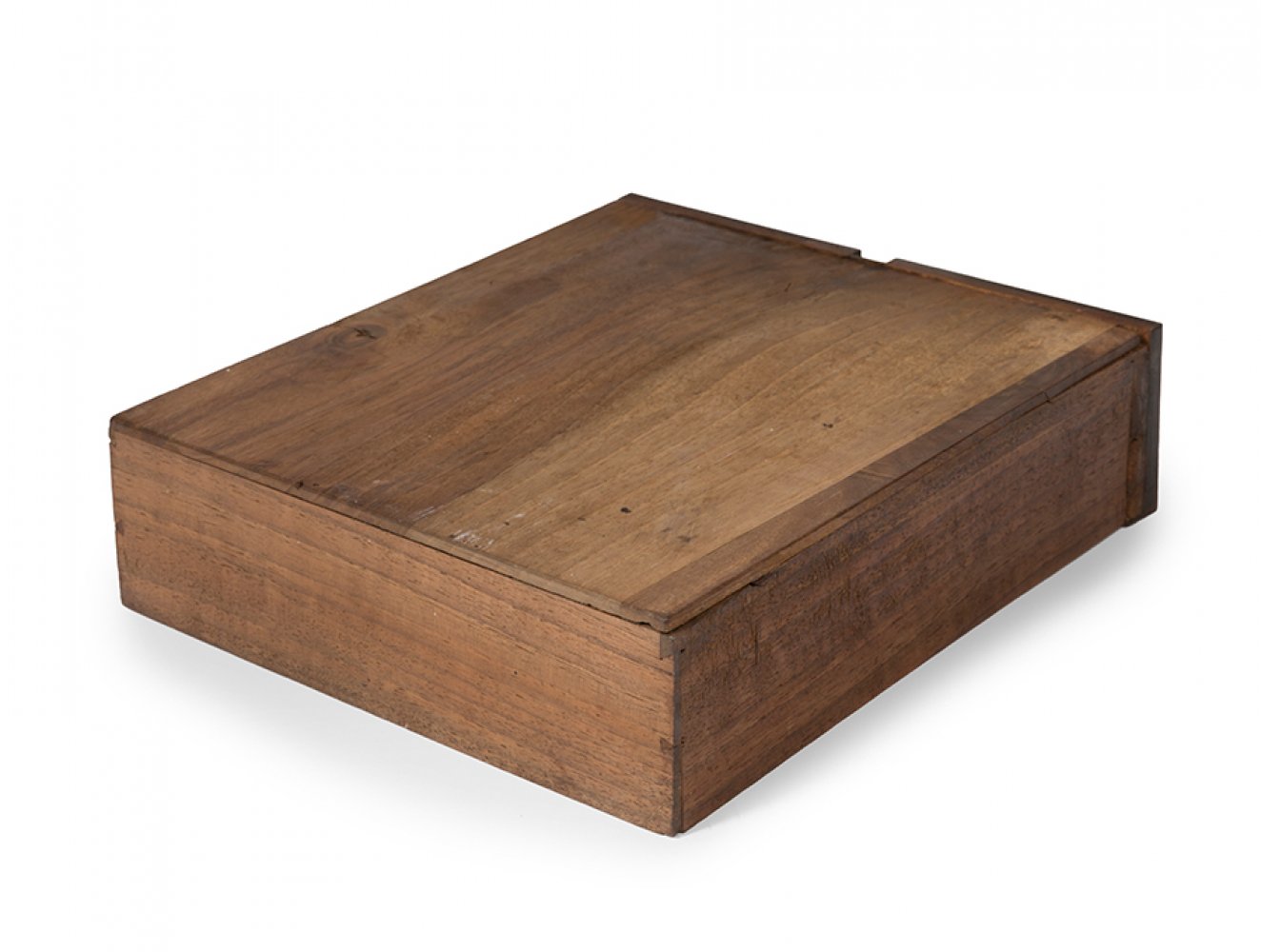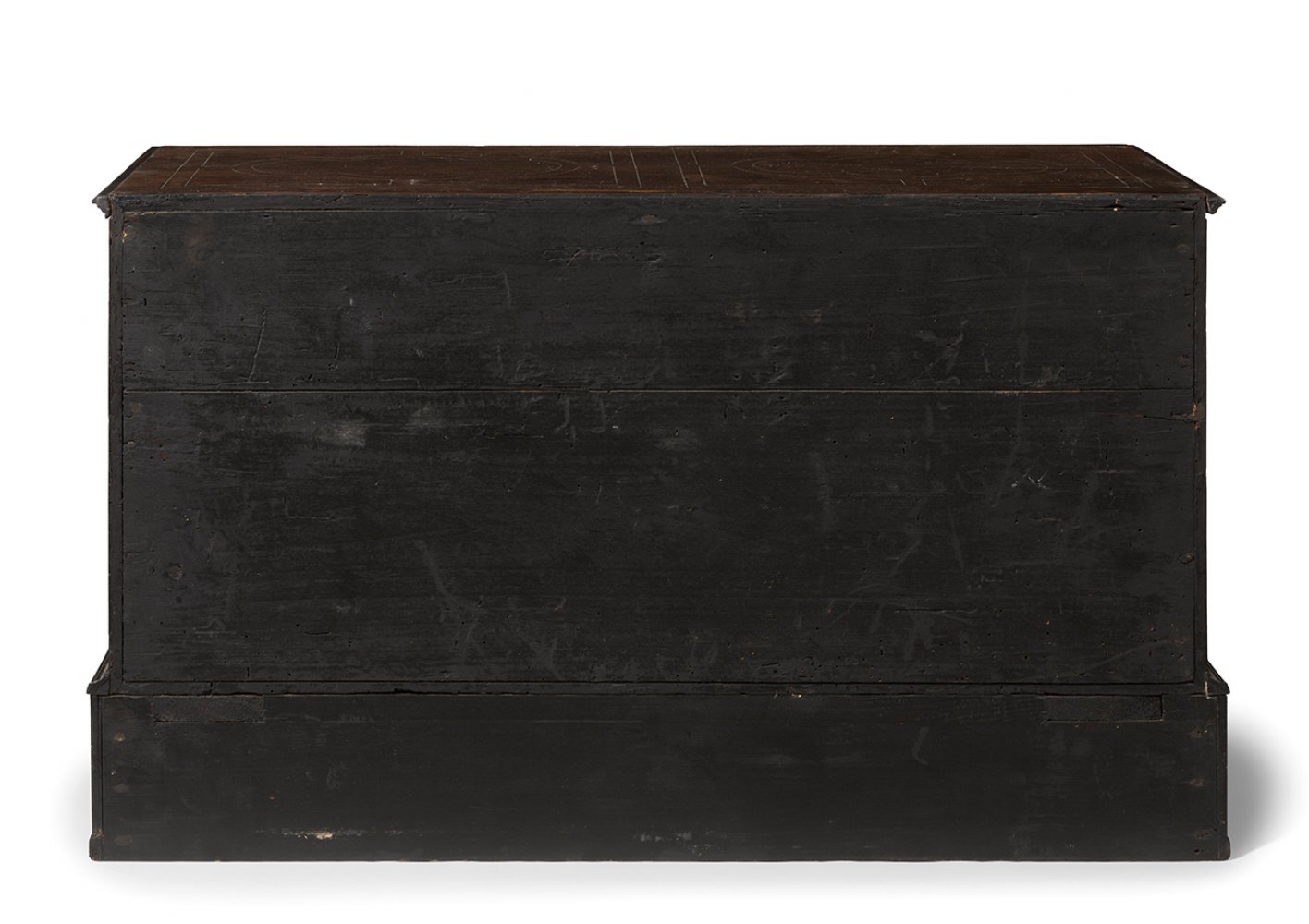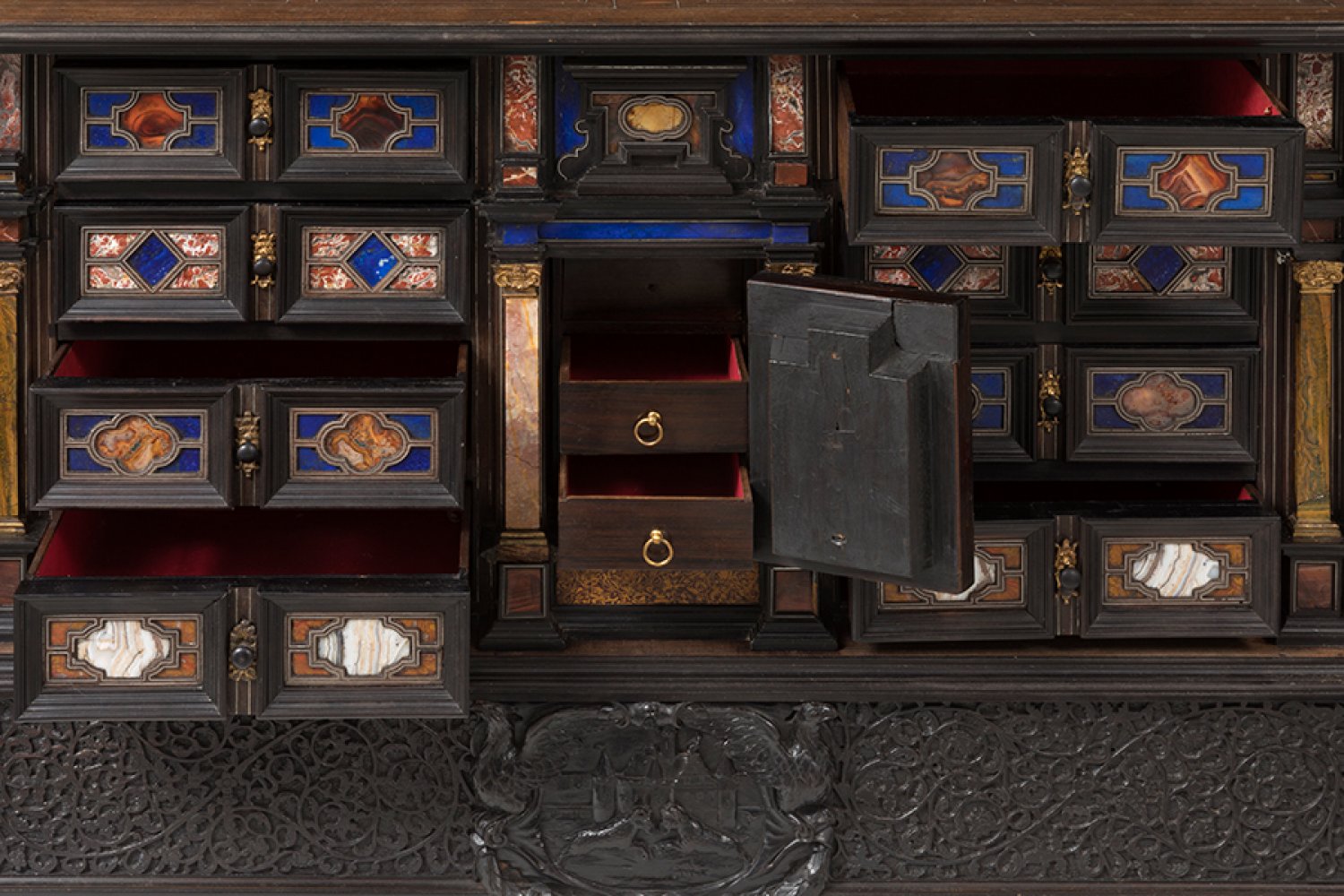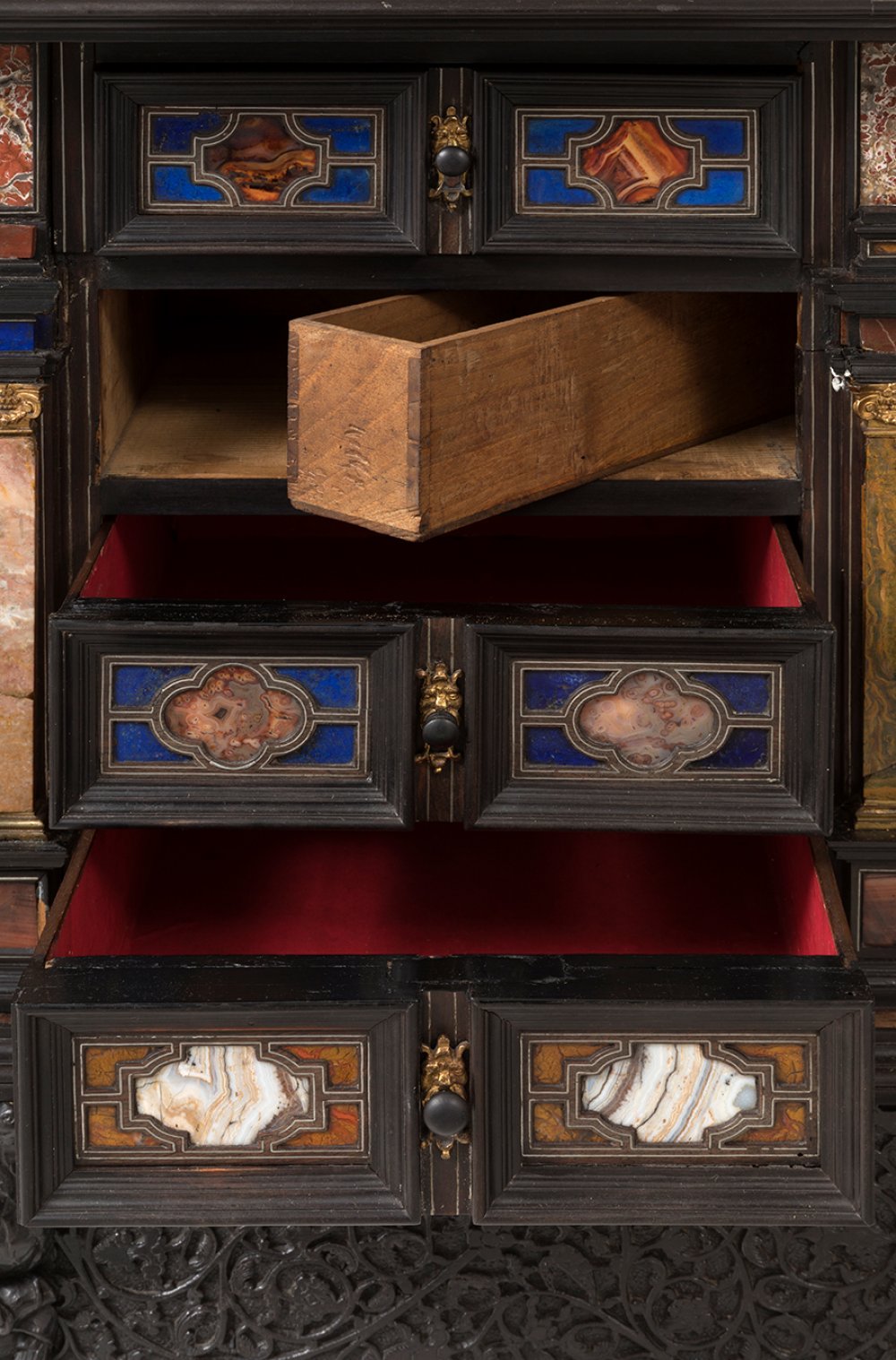5
Cabinet; Italy, 17th century.Wood, lapis lazuli, agate, jasper marble, bronze and silver.It shows
1/7
Description
Cabinet; Italy, 17th century.
Wood, lapis lazuli, agate, jasper marble, bronze and silver.
It shows faults, restorations and losses.
Measurements: 49 x 74 x 32 cm.
High quality and beautiful piece of furniture with the interiors made of wood. The front is divided into three sections separated by columns of marbled marble, of Corinthian order, with capitals and bases in gilded bronze. The side sections, made up of drawers, are decorated with mouldings, brass plaques and hard stones such as lapis lazuli, with round handles. The central body, topped by a pediment, houses the gilt-bronze sculpture of an adult man leaning on a staff, which could be a representation of the god Asclepius, who in classical mythology was considered to be the god of medicine. The ornamentation of the piece of furniture goes beyond the front, as both the sides and the upper part have a geometrically structured fillet that serves as ornamentation. In addition, the base also has an aesthetic finish based on a profuse relief on the front in laceria and a central border depicting the figure of two animals facing each other. It is worth noting that the cabernet hides several secret compartments that can be accessed by removing the main drawers.
It is a piece that faithfully follows Italian models, in which it was common to combine different materials in search of contrasting colours and qualities. The markedly architectural structure is also typical of the Italian school and, in fact, even the typology itself, given that in the 17th century the cabinet or desk was the furniture par excellence throughout Europe.
Wood, lapis lazuli, agate, jasper marble, bronze and silver.
It shows faults, restorations and losses.
Measurements: 49 x 74 x 32 cm.
High quality and beautiful piece of furniture with the interiors made of wood. The front is divided into three sections separated by columns of marbled marble, of Corinthian order, with capitals and bases in gilded bronze. The side sections, made up of drawers, are decorated with mouldings, brass plaques and hard stones such as lapis lazuli, with round handles. The central body, topped by a pediment, houses the gilt-bronze sculpture of an adult man leaning on a staff, which could be a representation of the god Asclepius, who in classical mythology was considered to be the god of medicine. The ornamentation of the piece of furniture goes beyond the front, as both the sides and the upper part have a geometrically structured fillet that serves as ornamentation. In addition, the base also has an aesthetic finish based on a profuse relief on the front in laceria and a central border depicting the figure of two animals facing each other. It is worth noting that the cabernet hides several secret compartments that can be accessed by removing the main drawers.
It is a piece that faithfully follows Italian models, in which it was common to combine different materials in search of contrasting colours and qualities. The markedly architectural structure is also typical of the Italian school and, in fact, even the typology itself, given that in the 17th century the cabinet or desk was the furniture par excellence throughout Europe.
Auction Details
Shipping
T&Cs & Important Info
Ask seller a question
Cabinet; Italy, 17th century.
Wood, lapis lazuli, agate, jasper marble, bronze and silver.
It shows faults, restorations and losses.
Measurements: 49 x 74 x 32 cm.
High quality and beautiful piece of furniture with the interiors made of wood. The front is divided into three sections separated by columns of marbled marble, of Corinthian order, with capitals and bases in gilded bronze. The side sections, made up of drawers, are decorated with mouldings, brass plaques and hard stones such as lapis lazuli, with round handles. The central body, topped by a pediment, houses the gilt-bronze sculpture of an adult man leaning on a staff, which could be a representation of the god Asclepius, who in classical mythology was considered to be the god of medicine. The ornamentation of the piece of furniture goes beyond the front, as both the sides and the upper part have a geometrically structured fillet that serves as ornamentation. In addition, the base also has an aesthetic finish based on a profuse relief on the front in laceria and a central border depicting the figure of two animals facing each other. It is worth noting that the cabernet hides several secret compartments that can be accessed by removing the main drawers.
It is a piece that faithfully follows Italian models, in which it was common to combine different materials in search of contrasting colours and qualities. The markedly architectural structure is also typical of the Italian school and, in fact, even the typology itself, given that in the 17th century the cabinet or desk was the furniture par excellence throughout Europe.
Wood, lapis lazuli, agate, jasper marble, bronze and silver.
It shows faults, restorations and losses.
Measurements: 49 x 74 x 32 cm.
High quality and beautiful piece of furniture with the interiors made of wood. The front is divided into three sections separated by columns of marbled marble, of Corinthian order, with capitals and bases in gilded bronze. The side sections, made up of drawers, are decorated with mouldings, brass plaques and hard stones such as lapis lazuli, with round handles. The central body, topped by a pediment, houses the gilt-bronze sculpture of an adult man leaning on a staff, which could be a representation of the god Asclepius, who in classical mythology was considered to be the god of medicine. The ornamentation of the piece of furniture goes beyond the front, as both the sides and the upper part have a geometrically structured fillet that serves as ornamentation. In addition, the base also has an aesthetic finish based on a profuse relief on the front in laceria and a central border depicting the figure of two animals facing each other. It is worth noting that the cabernet hides several secret compartments that can be accessed by removing the main drawers.
It is a piece that faithfully follows Italian models, in which it was common to combine different materials in search of contrasting colours and qualities. The markedly architectural structure is also typical of the Italian school and, in fact, even the typology itself, given that in the 17th century the cabinet or desk was the furniture par excellence throughout Europe.
29th December - Old Masters
Sale Date(s)
Venue Address
Aragón 346, Barcelona
Calle Velázquez 7, Madrid
Carrer de Cirilo Amorós 55, Valencia
Barcelona
08009
Spain
General delivery information available from the auctioneer
Setdart offers Worldwide shipping
PICK UP IN ROOM: You can come and pick up your lots in our offices (Barcelona, Madrid or Valencia). At the moment of the withdrawal, you will be able to accept the current conditions of the lot by means of a document that you will sign.
YOU CAN SEND ANOTHER PERSON TO PICK UP: This person must present a signed authorization that you can find in our web page by accessing from BUY AT SETDART- LOGISTICS-DOWNLOAD AUTHORIZATION DOCUMENT. You can also send an e-mail with the requested data in AUTHORIZATION DOCUMENT to admin@setdart.com
Important Information
25% buyer´s premium
21% buyer´s premium at www.setdart.com















